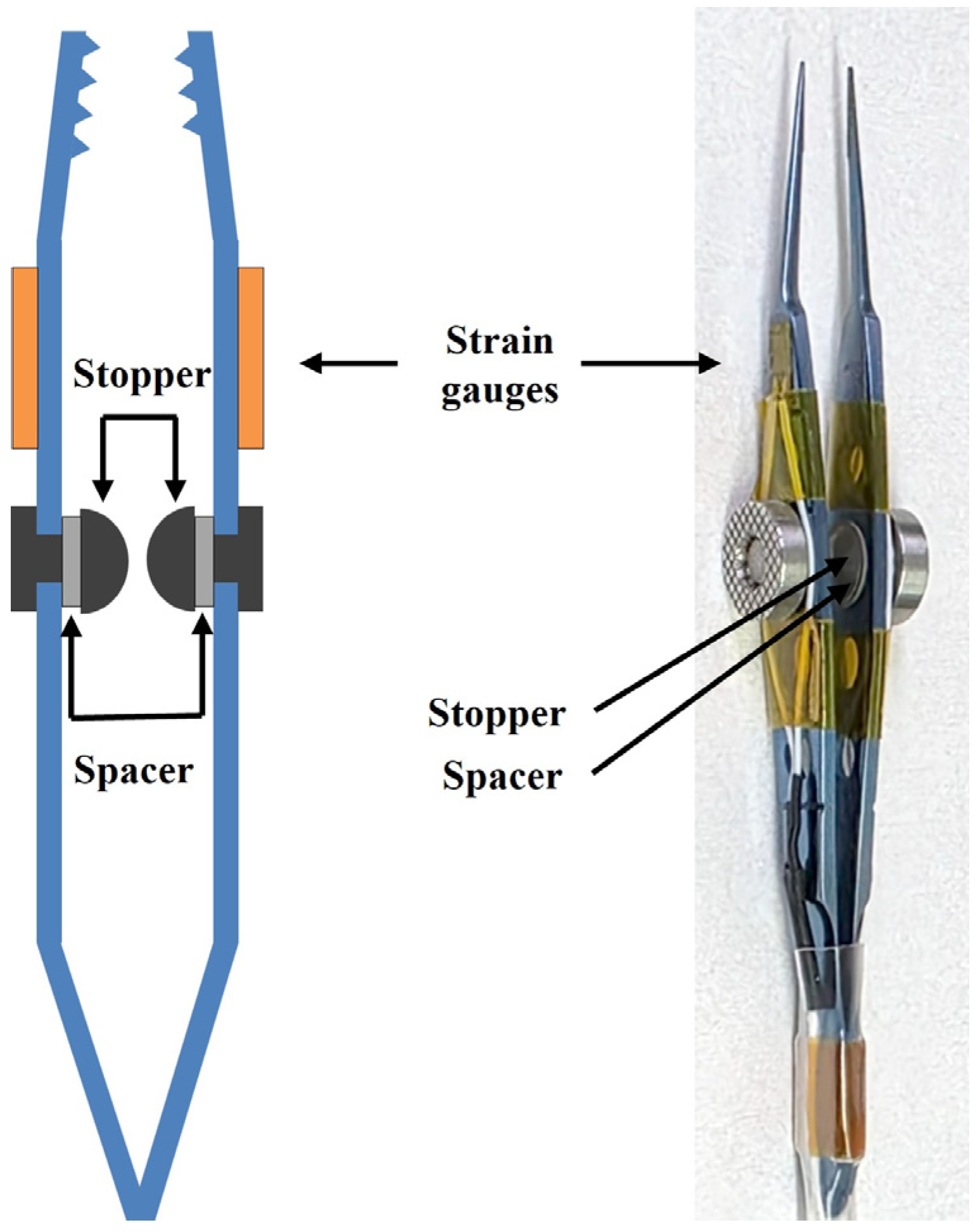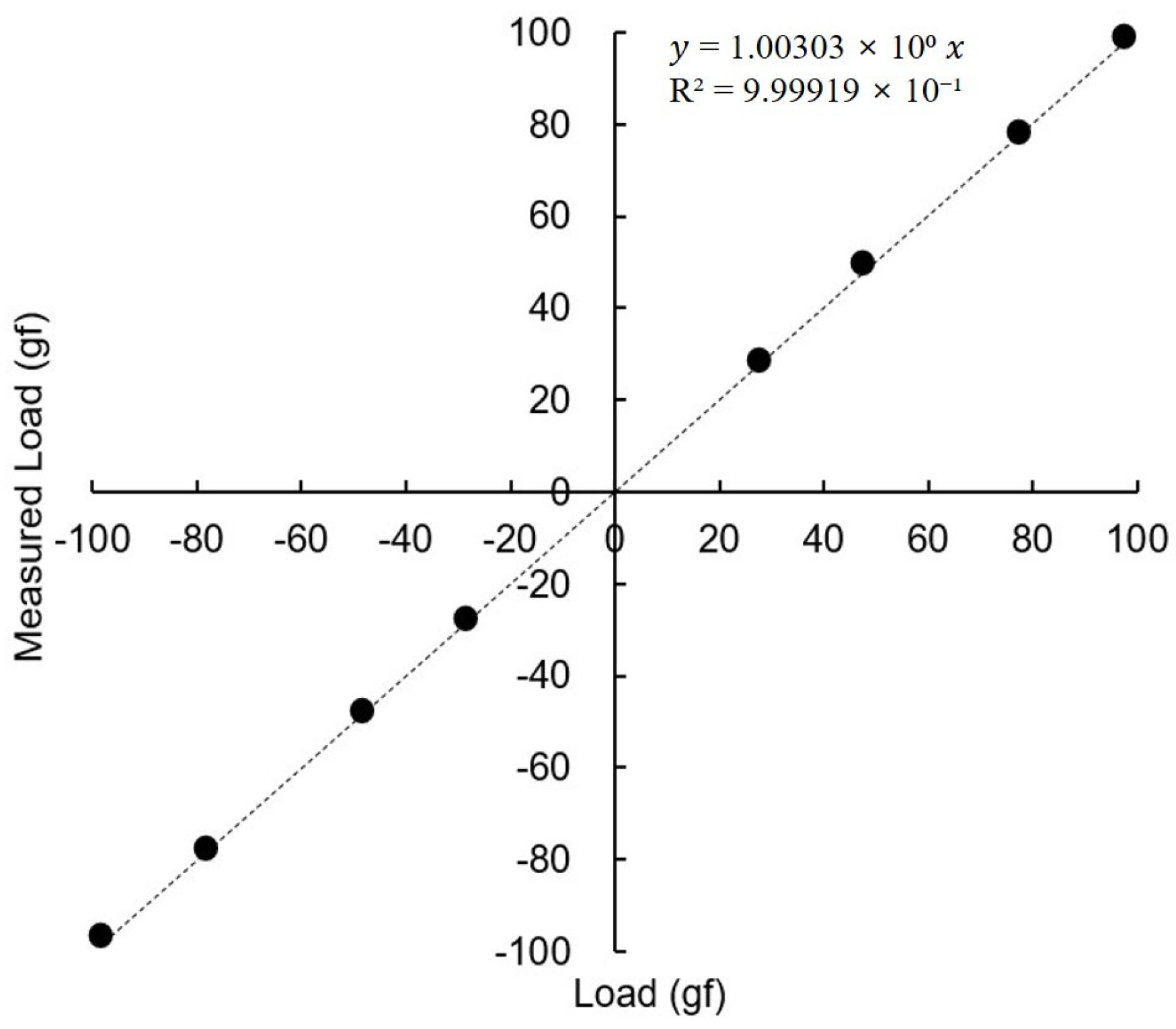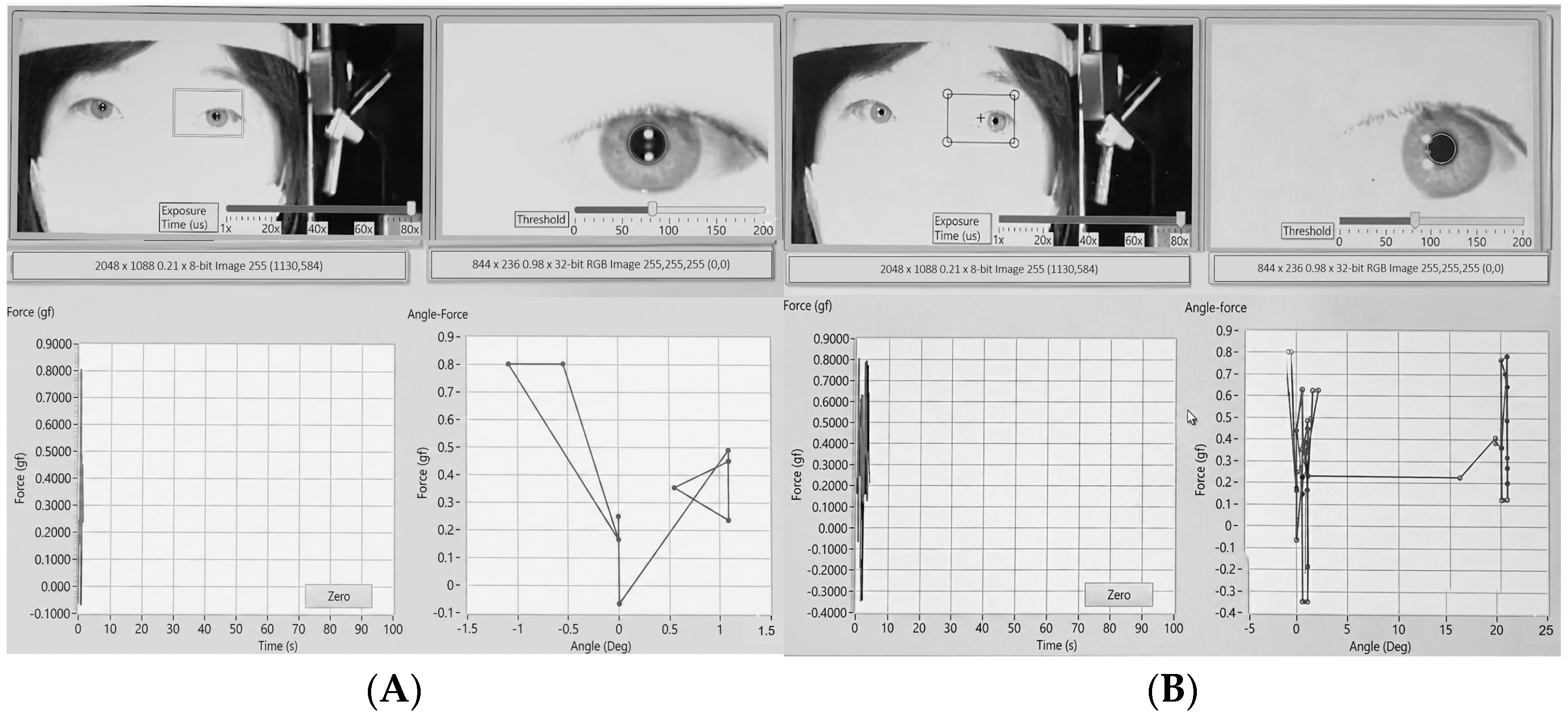Novel System for Measuring Tension Force in Eyeball Movement
Abstract
1. Introduction
2. Materials and Methods
2.1. System Overview
2.2. Passive Tension Measurement Subsystem
2.2.1. Forceps with Integrated Strain Gauges
2.2.2. Signal Processing and Wireless Transmission
2.2.3. Calibration
2.3. Ocular Rotation Angle Measurement Subsystem
2.3.1. Hardware and Image Acquisition
2.3.2. Image Processing and Angle Calculation
2.4. Subject-Specific Pre-Measurement Procedures
2.4.1. Measurement of Individual Ocular Radius (R)
2.4.2. Determination of the Zero-Degree Reference Point
2.5. Clinical Measurement Protocol
3. Results
4. Discussion
5. Conclusions
Author Contributions
Funding
Institutional Review Board Statement
Informed Consent Statement
Data Availability Statement
Acknowledgments
Conflicts of Interest
Abbreviations
| FDT | Forced Duction Test |
| PCB | Printed Circuit Board |
| IR | Infra-Red |
References
- Blake, R.; Wilson, H. Binocular vision. Vis. Res. 2011, 51, 754–770. [Google Scholar] [CrossRef]
- Otero-Millan, J.; Macknik, S.L.; Martinez-Conde, S. Fixational eye movements and binocular vision. Front. Integr. Neurosci. 2014, 8, 52. [Google Scholar] [CrossRef] [PubMed]
- Liu, G.T.; Volpe, N.J.; Galetta, S.L. Eye movement disorders. Curr. Opin. Ophthalmol. 1995, 6, 27–33. [Google Scholar] [CrossRef] [PubMed]
- Stephens, K.F.; Reinecke, R.D. Quantitative forced duction. Trans. Am. Acad. Ophthalmol. Otolaryngol. 1967, 71, 324–329. [Google Scholar] [PubMed]
- Metz, H.S. Forced Duction, Active Force Generation, and Saccadic Velocity Tests. Int. Ophthalmol. Clin. 1976, 16, 47–73. [Google Scholar] [CrossRef] [PubMed]
- Rosenbaum, A.L.; Myer, J.H. New Instrument for the Quantitative Determination of Passive Forced Traction. Ophthalmology 1980, 87, 158–163. [Google Scholar] [CrossRef] [PubMed]
- Collins, C.C.; Carlson, M.R.; Scott, A.B.; Jampolsky, A. Extraocular muscle forces in normal human subjects. Investig. Ophthalmol. Vis. Sci. 1981, 20, 652–664. [Google Scholar]
- Metz, H.S.; Cohen, G.H. Quantitative Forced Duction Measurements. Am. Orthopt. J. 1984, 34, 28–38. [Google Scholar] [CrossRef]
- Shin, H.J.; Lee, S.J.; Oh, C.-S.; Kang, H. Novel compact device for clinically measuring extraocular muscle (EOM) tension. J. Biomech. 2020, 109, 109955. [Google Scholar] [CrossRef] [PubMed]
- Kang, H.; Lee, S.-H.; Shin, H.J.; Lee, A.G. New instrument for quantitative measurements of passive duction forces and its clinical implications. Graefe’s Arch. Clin. Exp. Ophthalmol. 2020, 258, 2841–2848. [Google Scholar] [CrossRef]
- Kang, H.; Lee, S.-H.; Oh, C.-S.; Shin, H.J.; Lee, A.G. Quantitative measurement of passive duction force tension in intermittent exotropia and its clinical implications. Graefe’s Arch. Clin. Exp. Ophthalmol. 2021, 259, 1617–1623. [Google Scholar] [CrossRef]
- Shin, H.J.; Kim, S.; Kang, H.; Lee, A.G. Novel Instrument for Clinical Evaluations of Active Extraocular Muscle Tension. Appl. Sci. 2023, 13, 11431. [Google Scholar] [CrossRef]
- Shin, H.J.; Park, M.; Kang, H.; Lee, A.G. Novel Device for Intraoperative Quantitative Measurements of Extraocular Muscle Tensile Strength. Biosensors 2025, 15, 347. [Google Scholar] [CrossRef]
- Scott, A.B.; Collins, C.C.; O’Meara, D.M. A Forceps to Measure Strabismus Forces. Arch. Ophthalmol. 1972, 88, 330–333. [Google Scholar] [CrossRef] [PubMed]
- Metz, H.S. Quantitative Evaluation of the Strabismus Patient. Int. Ophthalmol. Clin. 1985, 25, 13–36. [Google Scholar] [CrossRef] [PubMed]
- Quaia, C.; Ying, H.S.; Nichols, A.M.; Optican, L.M. The Viscoelastic Properties of Passive Eye Muscle in Primates. I: Static Forces and Step Responses. PLoS ONE 2009, 4, e4850. [Google Scholar] [CrossRef] [PubMed]
- Iwashige, H.; Ishida, T.; Koike, N.; Kubota, N. Measurements of active and passive force of horizontal muscles in strabismus. Jpn J. Ophthalmol. 1988, 32, 223–235. [Google Scholar] [PubMed]
- Simonsz, H.J.; Kolling, G.H.; Kaufman, H.; van Dijk, B. Intraoperative Length and Tension Curves of Human Eye Muscles. Arch. Ophthalmol. 1986, 104, 1495–1500. [Google Scholar] [CrossRef] [PubMed]
- Mirzajani, H.; Mirlou, F.; Istif, E.; Singh, R.; Beker, L. Powering smart contact lenses for continuous health monitoring: Recent advancements and future challenges. Biosens. Bioelectron. 2022, 197, 113761. [Google Scholar] [CrossRef]
- Han, F.; Ge, P.; Wang, F.; Yang, Y.; Chen, S.; Kang, J.; Ren, Y.; Liu, H.; Wei, Z.; He, Y.; et al. Smart contact Lenses: From rational design strategies to wearable health monitoring. Chem. Eng. J. 2024, 497, 154823. [Google Scholar] [CrossRef]





Disclaimer/Publisher’s Note: The statements, opinions and data contained in all publications are solely those of the individual author(s) and contributor(s) and not of MDPI and/or the editor(s). MDPI and/or the editor(s) disclaim responsibility for any injury to people or property resulting from any ideas, methods, instructions or products referred to in the content. |
© 2025 by the authors. Licensee MDPI, Basel, Switzerland. This article is an open access article distributed under the terms and conditions of the Creative Commons Attribution (CC BY) license (https://creativecommons.org/licenses/by/4.0/).
Share and Cite
Sung, J.Y.; Kim, J.M.; Doh, I.; Lee, Y.-H. Novel System for Measuring Tension Force in Eyeball Movement. Biosensors 2025, 15, 769. https://doi.org/10.3390/bios15120769
Sung JY, Kim JM, Doh I, Lee Y-H. Novel System for Measuring Tension Force in Eyeball Movement. Biosensors. 2025; 15(12):769. https://doi.org/10.3390/bios15120769
Chicago/Turabian StyleSung, Jae Yun, Ju Mi Kim, Il Doh, and Yeon-Hee Lee. 2025. "Novel System for Measuring Tension Force in Eyeball Movement" Biosensors 15, no. 12: 769. https://doi.org/10.3390/bios15120769
APA StyleSung, J. Y., Kim, J. M., Doh, I., & Lee, Y.-H. (2025). Novel System for Measuring Tension Force in Eyeball Movement. Biosensors, 15(12), 769. https://doi.org/10.3390/bios15120769




